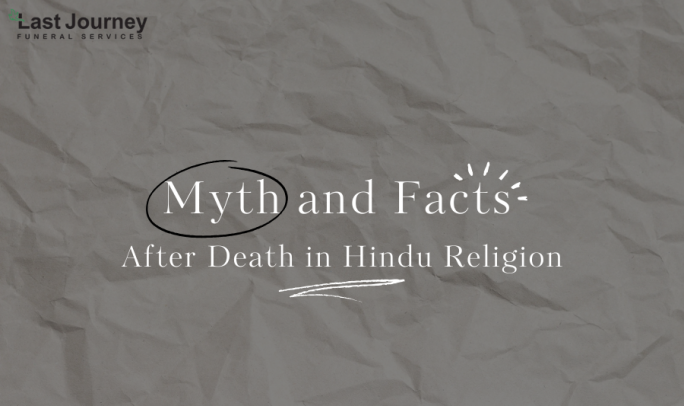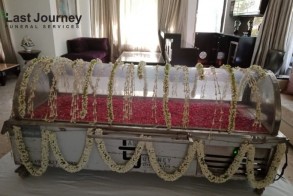Lastjourney Blog
Cultural Perspectives: Myth and Facts in Hindu Religion After Death

 Table of Contents
Table of Contents- Some widespread myths and misunderstandings about the final rites in Hinduism
- What is the right way to perform a dignified farewell for the departed soul away from the myths and misunderstandings?
Due to being the oldest religion, Hinduism has a unique set of spiritual ways to conduct any Sanskara. Death is one of them. In Hinduism, it is believed, that after demise the soul leaves the deceased body and strives to get another body. With each phase of rebirth and death, the soul gets closer to Brahm "the phase where salvation is achieved'.
To offer peace, dignity, and freedom from the cycle of birth and death, a few final rites are performed by the lead mourner of the family and he will be accompanied by all the near and dear ones.
Due to having so many rituals included, some customs are often misunderstood by the people. Here, in this article, you can have detailed information about the myths and facts related to the demise of Hindu Religion.
Some widespread myths and misunderstandings about the final rites in Hinduism
Myth I: Considering the importance of the soul lesser than the deceased body
It is believed that the departed soul revolves around the human remains or the dead body after demise. The family members do not allow kids and females to go close to the deceased body due to this misconception.
Fact: But the fact is the final rituals like cremation are performed for the liberation and peace of the departed Soul. The physical remains are preceded by a complete process, but followers of Hinduism do not look at the physical existence of the body, but the soul's peaceful journey. The final rituals determined by the Hindu Vedic scriptures are more symbolic and are solely focused on freeing the soul from attachments to the physical world.
Myth 2: The funeral in Hinduism includes only the Cremation ritual.
It is believed that cremation is the only way to offer a dignified farewell to the deceased person. These days traditional wooden cremation and advanced cremating ways are picked only
Fact: Due to being chosen by most of the followers of Hinduism, cremation is considered only way of bidding adieu to the departed soul. But the fact is, it is not the only way of offering farewell. In the ancient times, several saints chose burial instead of cremation as they were spiritually evolved. The reason behind choosing burial over cremation was breaking all the bonds from the physical world and body way before than the soul left the body. Another thing is, infants and young children are buried in Hindu religion. The reason behind it is very similar. Their souls are believed to be pure and untouched by karma.
Myth 3: Only the well-learned Hindu priest can perform or guide the lead mourner during the execution of the final rituals.
Fact: It is not mandatory to hire a Hindu priest to perform the last rituals such as cremation, Teharavin, Chautha and Pind Daan etc. The male lead mourner of the deceased person can perform them all by himself if he has detailed information about the customs related to the death.
What is the right way to perform a dignified farewell for the departed soul away from the myths and misunderstandings?
Here are the key tasks that the lead mourner should perform.
- The lead mourner with the help of other male family members wash the deceased body with ghee, honey, milk, and yoghurt etc.
- It is necessary to place essential oils on the head of the deceased body.
- The hands of deceased body should be placed in such position that the palms are downwards and the toes of the feet should be tied together.
- According to the religious rules the deceased’s body should be dressed in new and white clothes.
- For the dignified cremation of father, a floral garland should be placed of the perfectly wraped deceased body. The pindas 'rice balls' can also take place close to the remains.
- A lamp should be placed close to the head of the dead body. The lead mourner should sprinkle Ganga Jal on the body to make it sacred before igniting the pyre.
After how much time, the cremation rite should be performed after demise?
According to Hindu death rituals, the body should be cremated before sunset. Hence, the remains can be kept at the home for 3-4 hours maximum after demise.
How can you plan a dignified funeral before the cremation ritual?
- The very first step is carrying the casket at a funeral hall where all the mourners recite a prayer and console each other. They also remember the life and legacy of the departed person.
- In an open casket with glass display, the deceased's body is placed. Here all the guests or visitors are expected to see the dead body for the last time. According to the Hindu Scriptures, this entire funeral process should be done respectfully and attendees should not touch the person who has died.
- Once the funeral or Antim Darshan ritual is completed, the dead body is carried to the cremation ground for offering it Mukhagni.
- Ideally, the mukhagni or cremation is only attended by the male members of the family and other known ones, however, these days, hindu families allow women to attend the cremation.
- The day after the Mukhagni, the remains or ashes are collected in an urn and will be scattered over a sacred water body (ideally Ganga River) or a place of importance to the deceased.
What is the mourning period after the death of a father in the Hindu Religion?
The Teharavin ritual is considered the ending of the 13-day-long lamenting period. In Teharavin, the below given tasks are included -:
- A specific person called Mahapatra is invited to lead the family during the Teharavin ritual.
- Rice balls (pindas) are prepared for offering them to the departed soul.
- 13 Brahmins are invited for having the Vegetarian food (Satvik Food) in the end.
- The lead male member (son) offer Clothes, utensils and Cash to the Brahmins as well as Mahapatra in the end of the Teheravin Ritual.
Your email address will not be published. Required fields are marked *












